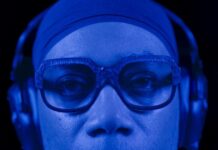
*The more time you spend staring at a computer screen or smartphone the more strain you’re putting on your eyes.
As reported by Get Pocket, “When our eyes spend more time focusing on near objects, like phones, screens or even paperbacks, it makes our eyeballs elongate, which prevents the eye from bending light the way it should,” the outlet writes.
This increases nearsightedness called myopia, which affects half of young adults in the US. Myopia causes distant objects to appear blurred. It is an eye-focusing disorder that affects an estimated 25% of Americans.
As reported by the American Academy of Optometry, Myopia in children can be inherited if a parent has the disorder.
READ MORE: Groups Are Uniting to Oppose Landmark California Mental Health Legislation
Here’s more from the report:
In the spring of 2020, Chinese researchers tested over 120,000 Covid-quarantined students aged six to eight and found myopia and other vision issues linked to home confinement increased up to three times compared with the previous five years – that’s with as little as 2.5 more hours of e-learning (not counting video games, social media, etc). Results for US students could be much higher since many American kids spend most of their days online.
“Virtual learning has definitely increased myopia,” says Dr. Luxme Hariharan, of the Nicklaus children’s hospital in Miami, Florida. “Prolonged near work [like looking at screens up close] makes our eyes overcompensate.”
“We can clinically measure the millimeter lengthening of the eyeball,” explains Dr. Eric Chow, a Miami, Florida optometrist. “Studies have shown that the longer the axial length, the higher the risk of eye diseases like glaucoma, retinal detachment and cataracts.”
Straining vision can cause a host of eye-related health problems.
“People say ‘oh, it’s just glasses,’” says Dr. Aaron Miller, a pediatric ophthalmologist at Houston Eye Associates. “The nearsighted have much higher chances of retina tears and glaucoma, bigger issues secondary to nearsightedness. It’s the long game we worry about.”
He adds: “The shape of the eye is round like a basketball,” he explains. “When an eye becomes nearsighted, myopic, the eye is longer, like a grape or olive. The retina – the coating – can get stretched and thinned. As we age, sometimes there can be breaks in the retina. Like cracks in wallpaper. When that occurs, these cracks cause fluid to enter in behind the wallpaper, that’s what we call retinal detachment which causes a lot of people to go blind.”
Per the report, “severe nearsightedness that progressively worsens and can lead to cataracts, glaucoma and retinal detachment – since the eyeball stretches and the retina thins – but thankfully, it’s rare. Risk grows with age, and can speed up gradual loss of the eye’s ability to focus, called presbyopia.”
There is no single cure for correcting myopia. The best method of correction should be explored with your ophthalmologist. Per the AAO, “Eyeglasses or contact lenses are the easiest and most common ways to correct vision problems.”
LASIK eye surgery can also “reshape the cornea with a laser to adjust how light travels through it,” per the report. Specialized contact lenses are another major corrective tool.
Parents can also use an FDA-registered vision screening app called GoCheckKids “to analyze how light refracts” and measure their child’s “risks for near or farsightedness and other eye diseases.”
Most important is taking breaks from the computer screen to rest the eyes.
“Every 20 minutes, look at a distance 20 feet away, for 20 seconds,” Hariharan advises. “Being on the computer for hours on end isn’t good for your health. Don’t break to play video games or pick up another screen. Go outside!”
We Publish News 24/7. Don’t Miss A Story. Click HERE to SUBSCRIBE to Our Newsletter Now!





